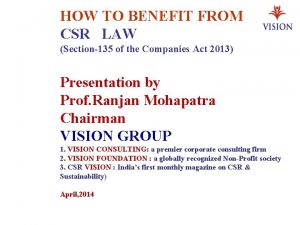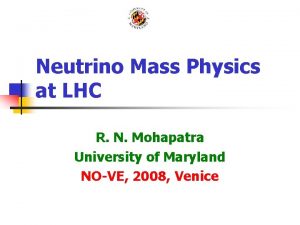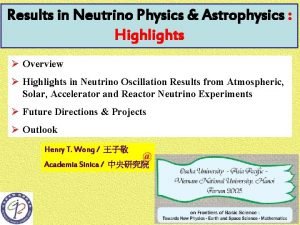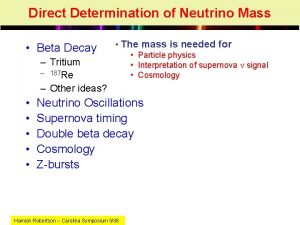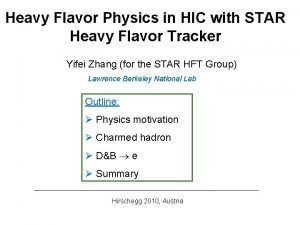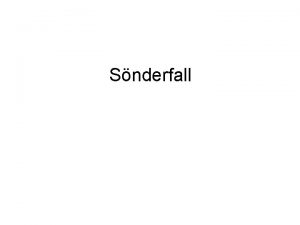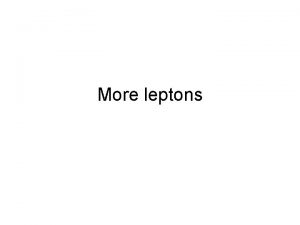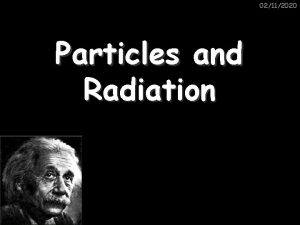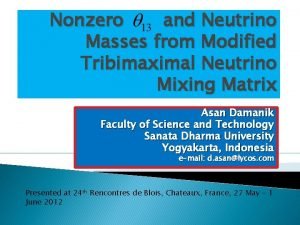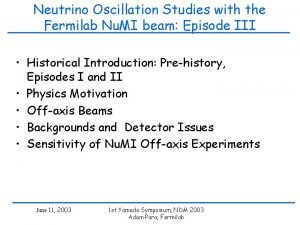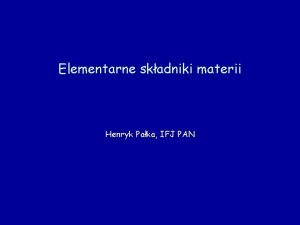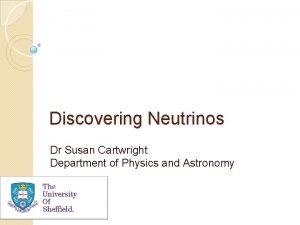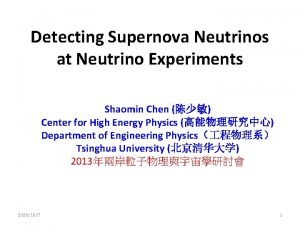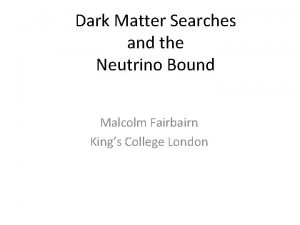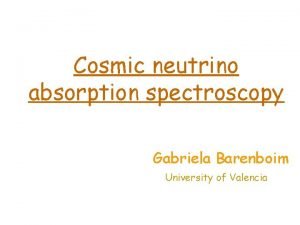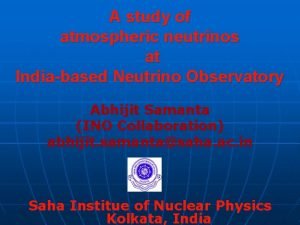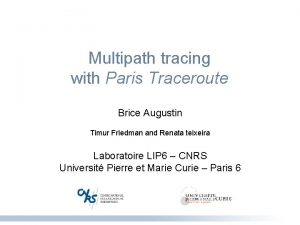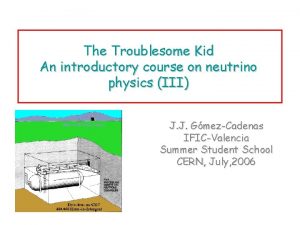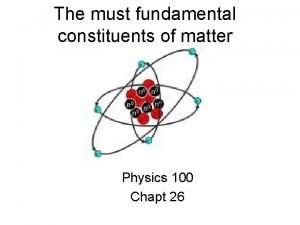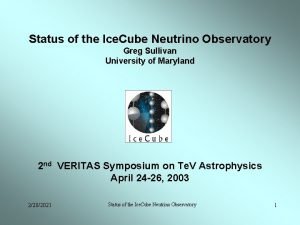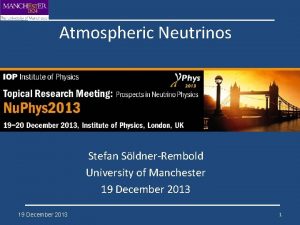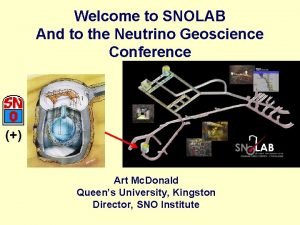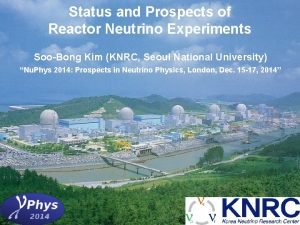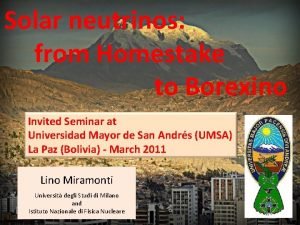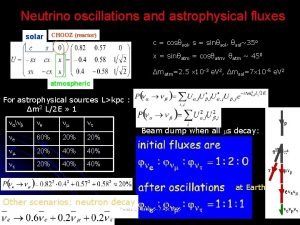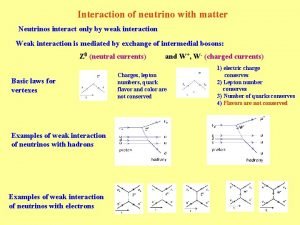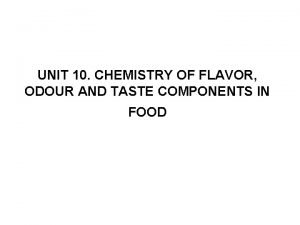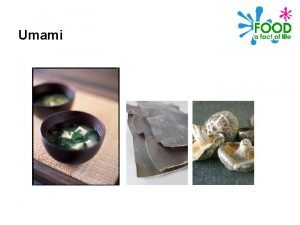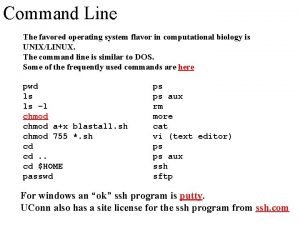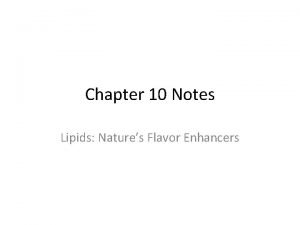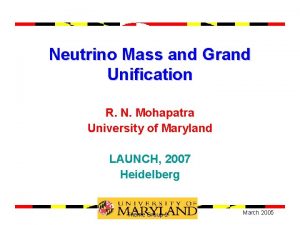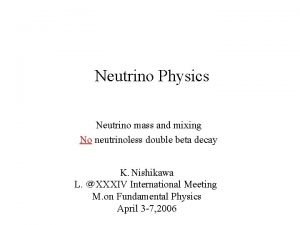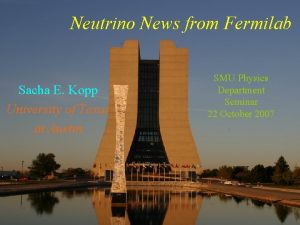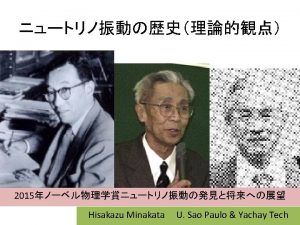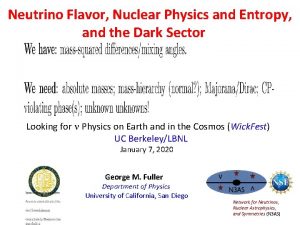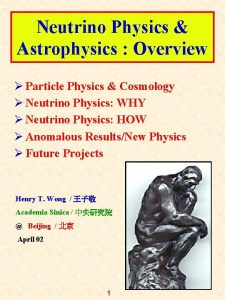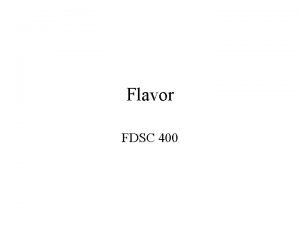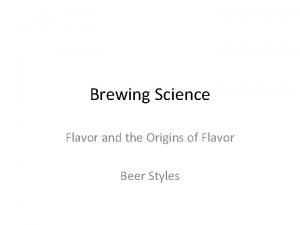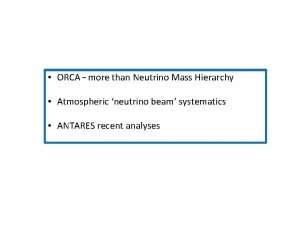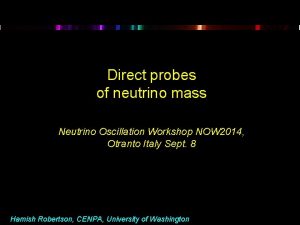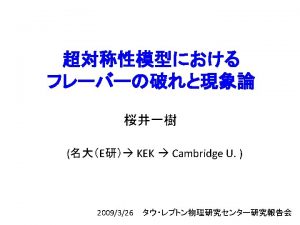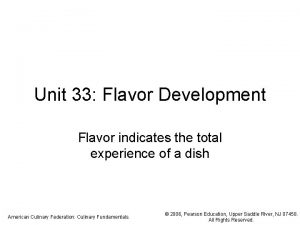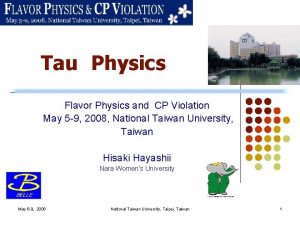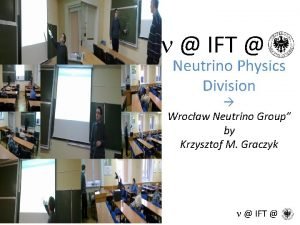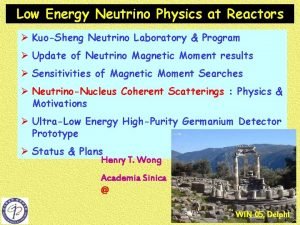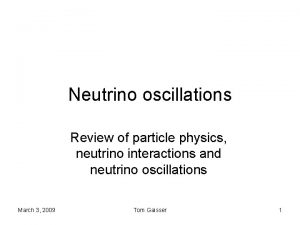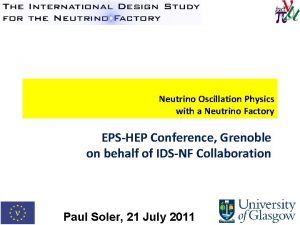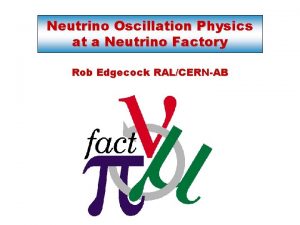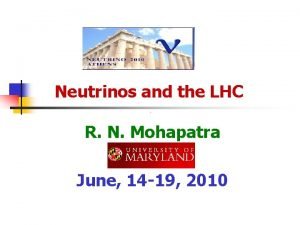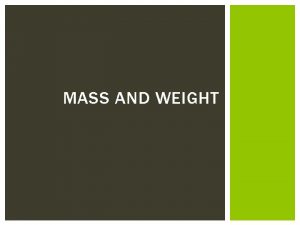Neutrino Mass and Flavor Physics R N Mohapatra




































- Slides: 36

Neutrino Mass and Flavor Physics R. N. Mohapatra

Neutrino Mass- What do we know ? n Masses: ; Mixings: ; Overall mass scale: <. 1 - 1 e. V (roughly) n To be determined (expts in progress or planning) n n (i) Majorana or Dirac ? (ii) Mass ordering: NH or IH (iii) Value of (iv) Any possible CP violation ? (v) Leptonic unitarity

Many experiments on the way (i) Majorana or Dirac (ii) Absolute mass scale: (iii) Mass ordering: (iv) Value of (v) CP phase

Plan of the talk n Neutrino mass New physics beyond SM: n Raises two new issues: n New mass scale to explain why Is it accessible at the LHC ? n New approach to flavor : Can we have a unified understanding quark- lepton mixings ?

Why n n ? Seesaw Paradigm: Add heavy right handed neutrinos play seesaw: to SM and Seesaw scale is the new physics scale !! Two different seesaws depending on whether N Majorana or Dirac

Type I seesaw n n n Majorana Breaks B-L : New scale and new symmetry beyond SM. After EWSB -Neutrino majorana key parameter to test seesaw n. Minkowski, Gell-Mann, Ramond Slansky, Yanagida, Mohapatra, Senjanovic, Glashow type I

Inverse Seesaw n Mostly Dirac n Seesaw parameter testing i. e. add another singlet or larger (RNM’ 86; RNM, Valle’ 86)

New physics signal for simplest seesaw n Strength given by n e. g. collider production: n n n or mixing: Leptonic non-unitarity: Both negligible for type I seesaw but observable for inverse seesaw MN ~ Te. V Situation different with gauge forces !!

1. Seesaw (B-L) scale n n Neutrino masses do not determine seesaw scale ; MU ~ Ge. V Both and high seesaw scale indication for SUSYGUTs; No collider signals ! (Common Lore) n B-L scale at Te. V LHC signalsseesaw with only gauge forces; No GUTs with type I. Inverse n B-L at Te. V and GUTs can co-exist: since possible (Dev, RNM’ 09)

A concrete realization: Low scale B-L in Left-Right n NR Gauge group: n New W’ and Z’ n n Fermion assignment Two Avatars of LR: type I Inverse seesaw +

Bound on SUSYLR scale from Low energy data n n M_WR > 2 Te. V from a combination of KL-KS, epsilon, d_n together. (uncertainty from long distance contribution); (An, Ji, Zhang’ 07)

Bounds from Nu-less double beta decay n n New contributions from WR-N exchange (only for Case I) (RNM, 86; Hirsch, Klapdor, Panella 96) Diagram: From Ge 76:

Seesaw signal from n Nu contribution: Inverse hierarchy Normal hierarchy Punch line: n Suppose long baseline n and nonzero signal for (+ RP if susy ) Te. V WR and type I

Constraints on Seesaw scale from coupling unification: n Te. V type I does not grand unify: Landau Pole n n (Kopp, Lindner, Niro, Underwood’ 09) (Parida, Sarkar, Majee, Raichaudhuri’ 09) n Discovery of type I signal at LHC will rule out GUTs.

Te. V Inverse Seesaw (LR) n Inverse seesaw n Look for not only susy but also WR, Z’, N at LHC: (Dev, RNM, does unify and give realstic model: with both WR and Z’ in Te. V range; MSSM GUT SUSYLR GUT 09; PRD);

SO(10) as the GUT theory n {16 }- spinor for all matter n Type I: only unification route: n Inverse seesaw:

Radiative Breaking of B-L and SM n n n Positive spartner mass square at GUT scale. RGE turns them negaitve much like SM with large t-mass (Dev, RNM’ 10)

LHC Signals for seesaw n n LHC production of WR: N-decay: type I Inv. Seesaw: Type I case: (Keung, Senjanovic; Han, Perez, Huang, Li, Wang; Del Aguila, Aguilar-Saavedra; Azuelos, . . ) n Inverse seesaw: Only Trileptons; no same sign dileptons(30 fb^-1) (del Aguila, Aguilar-Saavedra, de Blas) ;

Other Te. V scale Type I Signals n n n Te. V type I Seesaw requires B-L=2 Higgs: Doubly charged Higgs can have sub-Te. V mass. Decays to lepton pairs LHC signals for type I seesaw will rule out simple GUTs n Four lepton signals at LHC

New Dark matter in Te. V scale Inverse seesaw: n n If super-partner of RH neutrino is the lightest, it will be stable due to R-parity- become DM. Soft breaking: Minimal Type I case: Usual Bino. Lightest linear combination is dark matter: Higgsino n n

Dark matter in type I GUT vs Te. V scale Inverse seesaw: n Inverse seesaw case: (Fornengo, Arina, Bazzochi, Romao, Valle’ 08) New DM : : Two contributions to relic density: Z’ exchange (Matchev, Lee, Nasri) No or small Z’ effect

2. Understanding Flavor (i) Mass hierarchies (ii) Strange mixing patterns: Leptons: Quarks: UPMNS= UCKM = (Harrison, Perkins, Scott; He, Zee, Wolfenstein; Xing, . . )

Mass Texture n Up-quark and charged lepton diagonal basis: n n = Cabibbo angle

Strategy for texture n Key idea: SM has a large sym for zero fermion masses : [SU(3)]^5; n Choose subgroup: Discrete subgroup with 3 -d. rep. n Replace Yukawa’s by scalar fields (flavons); n Minima of the flavon theory determines Yukawas:

Application to Neutrinos n Successful Family symmetries for TBM: Flavon fields are triplets: (Ma, Rajasekaran; Babu, Ma, Valle, King, Ross; Altarelli, Feruglio, Chen, Mahanthappa; Everett, Ramond; Luhn, Nasri, Yu, RNM, Hagedorn, Morissi, …. . ) How can we unify with quarks ? Grand unified theories: SU(5)

High scale Ansatz for unifying quark-lepton flavor A n (Dutta, Mimura, RNM’PRD-09) f diagonal. Anarchic M 0, quark mixings small while lepton mixings large. Rank 1 M 0 B explains mass hierarchies + n

SUSY SO(10) realization n Fermions in {16}: n 16 mx 16 m={10}H+{126}H n Fermion masses from Yukawas as in SM: ( Babu, Mohapatra, 93)

Neutrino mass formula in GUT scale B-L in SO(10): Lazaridis, Shafi, Wetterich; R. N. M. , Senjanovic’ 81 n Type II seesaw:

SO(10) with GUT scale B-L unified approach to flavor n fermion mass formulae: n (Babu, Mohapatra’ 92) n n Bajc, Senjanovic, Vissani’ 03 For f, h’ << h, yields ansatz part A at MU; Rank from flavor symmetry: e. g.

An S 4 x. SO(10)- example n Solar mass n Bottom-tau: n Leading order PMNS: U Dutta, Mimura, RNM ar. Xiv: 0911. 2242 and (Harrison, Perkins, Scott; He, Zee, Xing; Wolfenstein) n Corrections: Testable Bjorken, King, Pakvasa Ferrandis; Chen, Mahanthappa n Double beta mass 3 me. V.

Prospects for measuring n Reactor, Long base line e. g. T 2 K, No. VA: (Lindner, Huber, Schwetz, Winter’ 09) Our prediction

Conclusion: n Te. V scale WR compatible with SO(10) GUT; Can be tested at LHC; New dark matter candidate: n New unified approach to flavor based on type. II+ SO(10)- testable via theta_13.

WR, Z’ at LHC_14 n n Production : WR Z’

Signals for Type I case n Two and three lepton signals in colliders n N-decay gives signal: n Like sign dilepton plus trilepton+ n (Han, Perez, Li, Del Aguila, Aguilar Saavedra, …)

Inverse seesaw case n N is mostly Dirac n Collider leptonic signal from WR production: n No like sign dilepton but only trileptons +

Distinguishing between seesaws n Observation of relative abundance of like sign dileptons vs trileptons can distinguish between Te. V scale Inverse seesaw vs type I seesaw n (Aguilar-Saavedra) n Type I n Inverse
 Ranjan mohapatra csr vision
Ranjan mohapatra csr vision Abhishek mohapatra
Abhishek mohapatra Neutrino mass
Neutrino mass Neutrino mass
Neutrino mass Heavy flavor physics
Heavy flavor physics Neutrino beteckning
Neutrino beteckning Leptons
Leptons Lepton number table
Lepton number table Neutrino
Neutrino Neutrino
Neutrino Lekka cząstka elementarna mion elektron lub neutrino
Lekka cząstka elementarna mion elektron lub neutrino Who discovered neutrino
Who discovered neutrino Neutrino
Neutrino Neutrino
Neutrino Gabriela barenboim
Gabriela barenboim Neutrino
Neutrino Paris traceroute
Paris traceroute Neutrino
Neutrino Neutrino symbol
Neutrino symbol Ice cube para status
Ice cube para status Neutrino
Neutrino Solar neutrino
Solar neutrino Neutrino
Neutrino Solar neutrino
Solar neutrino Solar neutrino
Solar neutrino Neutrino
Neutrino Neutrino interaction with matter
Neutrino interaction with matter Taste vs flavor
Taste vs flavor Examples of umami flavor
Examples of umami flavor Fema gras
Fema gras Contoh flavor alami
Contoh flavor alami Off flavor cerveza
Off flavor cerveza Taste vs flavor
Taste vs flavor Operating system flavor
Operating system flavor Cocktail flavor wheel
Cocktail flavor wheel Atom palm hydrogen
Atom palm hydrogen Setsman
Setsman
